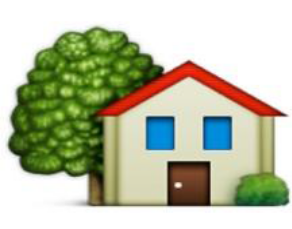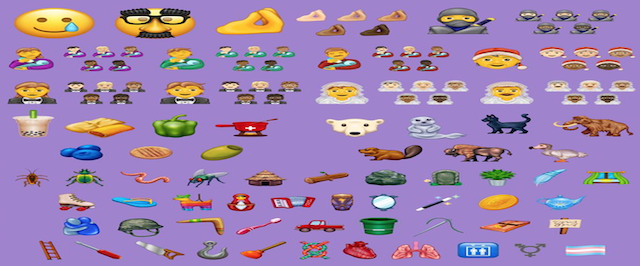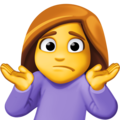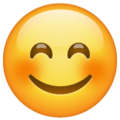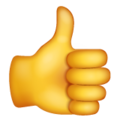Introduction
Since Internet has transformed in a short time into the fastest growing means of communication in human history, and after that developments in its services culminated in the emergence of its applications for the second generation (Web 2.0) which added another dimension to digital communication dominated by interaction among its users, It is under the eyes of researchers and academics who are interested in their studies and research papers that they presented in various national and international forums.
In turn, we had a share of studying and researching the subject of the Internet and social networks and their impact on the nature of human communication in the digital space, which was dominated by Interactivity in connection and communication among individuals in a new digital environment, so everyone participates, interacts and exchanges ideas and expresses his opinions and feelings in different forms and formats, but the issue that caught our attention is that language replete with abbreviations and “Emoji” expressive symbols, which spread with the spread of instant chat applications and comments in virtual reality, until it became widely circulated among users of the Internet and its platforms around the world.
Virtual communities’ follower will inevitably notice that emoji symbols have obtained their communication and interaction processes lion’s share among individuals, and after they depended in their communication on the written language, they moved to abbreviate and replace it with letters and numbers, such as: (b4 LOL, MDR), to get replaced later through this shortened language with the expressive symbols that dominated their conversations and connections, through which symbols, understandings and common specifications are exchanged amongst them allowing them expressing their social needs and individual desires.
Hence the idea for this article, in which we try to shed light on the symbolic interactive communication style based on emoji, hose icons, images, and shapes that are divided into different categories, some of which are related to expressive faces, people and things, and others to animals, activities and other categories.
Based on the foregoing, the problematic of our study centers on the following main question:
-
What does interactive communication based on expressive icons “ emojis” look like in the digital space?
In order to address this problematic, it was broken down into the following questions:
-
What are the characteristics of expressive symbols emojis?
-
What are the most popular expressive symbols emojis on social media applications and networks?
-
Why do individuals depend on these expressive symbols in their connection and interaction in virtual reality?
-
How did emojis symbols affect written languages?
1. The symbolic interactive communication nature based on “emoji” expressive symbols and icons
Communication is “a prerequisite for social interaction to occur, and it is the individual’s contact with others that determines the way he interacts with them.” Just as the individual lives in a world of symbols and knowledge surrounding him, and in every social situation or interaction, he is affected by it and uses it daily and constantly. It is clear from this that the individual uses symbols that carry many meanings at the level of his daily social life practice to express his social needs and individual desires.
On the other hand, researchers stress the importance of language in social interaction and the role of meanings and connotations in interpreting behavior and on the human ability to create and use symbols. (Basli, Hamdi, 2017, pp. 245-248)
And if we try to identify communication nature in the new communicative environment, we will find that it is an interactive communication that goes in two directions, not one. Some, like Levy and Massey, describe it as “human interaction” based on the idea of “user to user”. Which, according to researcher Galley Stromer, is more important than the interaction of the medium, because it is closer to re-forming the confrontational communication (face-to-face), and the Human interaction is defined as communication between two or more users that occurs through a communication channel such as the use of a message board, or the use of email links. (Nasr, 2015: 13)
For his part, researcher Abdel-Wahab Rami believes that the interactive approach is a fundamental principal structuring communication in cyberspace. What characterizes digital social networks is primarily interactive, multi-media, and cumulative. According to this interaction, the roles of people change from one moment to another, according to their activity degree and nature. And they act within it as senders and receivers at the same time, as in the case of normal daily speech.
The cumulative interaction also refers to the visitors’ comments, or what can be called “commenting on the comment.” (Rami, 2015: 5)
In addition to communication interactive nature in the digital space, we also find non-verbal (symbolic) communication, that is, it is dominated by emoji, which refer to a group of meanings, for example, feelings are reduced to icons, some of which indicate joy and contentment. And others indicate sadness and other symbols that it was agreed to be used by individuals in their conversations, communications and human connection in virtual reality instead of their standard language.
In this regard, the head of the Oxford Dictionaries, “Casper Grathol”, said in a statement in 2015 when an emoji was first introduced into its list of new terms: “You can imagine how the traditional alphabet is struggling to meet the rapid demand that focuses on the visual component of connect in the twenty-first century.” Grathol added, “Not surprisingly, figurative writing, like emojis, is stepping up to fill those gaps. As a result, emojis are increasingly becoming a rich form of connection, transcending linguistic boundaries.” (Al-Badarna, 2015)
It is noteworthy that the expressive symbol emoji identity goes back to Japan, where it appeared in 1998, and it is a term made up of two words, the first “e” meaning image and the second “moji” meaning symbol. (Onursoy, 2018, p 282 ). Given the spread of expressive symbols as a medium of communication and connection among Internet users and their good applications, July 17 of each year was chosen as the International Day of expressive symbols Emojis, knowing that the celebration of the International Day of these symbols began for the first time in 2014. (https://worldemojiday.com).
In 2015 expressive symbols took another international turn when the Oxford Dictionary announced in 2015 the word of the year, which is (Face with Tears of Joy), which means “the face with tears of joy” or “crying with joy” as the best word that reflects the feeling of that year, topping its annual list of new terms. Thus, for the first time ever, an expressive symbol was chosen for the most used terminology compared to other expressive symbols. (Al-Badarna, 2015).
As for the statistics related to the number of circulating and globally approved expressive symbols, the statista website indicated that their number is constantly increasing and does not show any indication of a decline in the popularity of emoji, as it reached more than 3000 symbols (3,019) during the year 2019. (Buchholz, 2019).
And in a statistic of the expressive symbols spread on the Facebook site, it turns out that nearly 5 billion expressive symbols are sent daily through the “Facebook Messenger” application, and about 60 million expressive symbols are commented on the social networking site ”Facebook“. (Essabah eldjadid, 2018), and people now have 3,019 emojis installed on their phones, and every year an average of 243 new messages are added. (emojivoter). These numbers indicate the predominance of symbolic communication in the digital space.
Figure N° 1 An infographic about the use of emoji symbols in the world during the year 2015
Source https://colibris.link/Bhlis
The above Figure shows the percentage of individuals who use expressive symbols in their communication and connection on the Internet and their daily correspondence, which is estimated at 92% of the users of this network, and the gender variable had an impact on the degree of use, where we find that women employ more frequently emoji symbols, at a rate of 78%, while the percentage of men is 60%.With regard to the emoji use in digital communication according to the age group variable, we note that the age group between 25 and 29 years uses symbols by 77%, followed by the age group of 25 years, which is represented by 72%, then individuals between the 30 and 34 years ages by 65%, and the 35 years age group and over occupies the last rank in the use of emoji with a percentage of 60%. (Visualistan, 2015).
2. Characteristics and types of emojis:
The reason behind the interest of those in charge of social networking platforms is to make continuous updates about its expressive symbols (emoji) on the one hand, and its transformation on the other hand to the most used communication tool by individuals in their communications with each other, whether via e-mail, social networks, or even their messages over the phone till the characteristics that distinguish it from them, including:
-
It is considered a universal language in itself that has crossed linguistic and cultural barriers.
-
Expressive symbols take many forms, pictures, and signs, and are divided into different categories: laughter, animals, things, foods, clothes...etc.
-
Works to embody realistically ideas, feelings and sensations, places.
-
Sometimes words cannot describe, and expressive symbols are more expressive of what we want to convey to others.
-
It conveys the meaning of the communicative message that the sender wants to send to the receiver and emphasizes it.
-
It gives expressive traits and features to the written text.
-
It goes beyond the direct linguistic meaning
-
It reduces the intensity of the read text and thus shortens the time and effort in communicating and connecting with the other party.
-
It plays a role in the effectiveness of digital communication, as the more individuals understand and participate in building the meanings that these symbols carry, the greater the interaction between them.
-
Flexible, instant, and makes a good impression. (Al-Badarna, 2015)
It is worth noting that expressive symbols are classified into several categories, including the emoticons (expressive faces) and people category, animals and nature category, drinks, food, activities, travel, places, and things category, symbols and banners category.
For example, Apple recently presented a list of 117 new expressive symbols that will arrive on devices such as: iPhone, iPad, Mac, Android devices and other devices in 2020 (apple-wd 2020), and that’s after Launching in the fall of 2019, the latest designs for several expressive symbols categories are included in this set of new symbols, with 59 symbols making up for 75 total variations when social diversity options are taken into account, and 230 options when skin tone options are included.Which will bring more variety to the keyboard from foods, animals, activities and smiley faces. (apple-wd, 2019).
On the other hand, many social networks have made updates on their platforms regarding emoji symbols. For example, the micro-blogging site Twitter added a set of 178 new expressive symbols on its platform after the approval of Unicode in October 2019 (emojipedia, 2019). Also, 230 new expressive symbols for 2019 have been added to WhatsApp (WhatsApp for Android), as part of the latest version of the popular messaging app. (emojipedia, 2020). The following is a table in which we highlight examples of each category of these symbols:
Table (1): Represents the different classifications of expressive symbols (emoji):
|
What does the symbol mean? |
Code |
Classified category |
|
Smiling face with open mouth |
|
Emoji faces |
|
Face tasting delicious taste joking tongue stick out |
|
Emoji faces |
|
Veiled girl |
|
People |
|
House with garden |
|
Places |
|
Monkey animal face |
|
Animals do not hear |
|
Flower bouquet |
|
Nature |
|
Heart gift |
|
Symbols |
|
a hundred points |
|
Symbols |
|
Pizza |
|
Food |
|
Tropical drink |
|
Drinks |
|
Algerian banner flag |
|
Banners |
|
Horseback riding |
|
Activities |
Source: Prepared by the researcher
Figure N° (2) The most popular new emoji list of 2020
Source: Emojipedia, (2020). The Most Popular New Emojis of 2020https://colibris.link/E1f7t
In this context, the electronic encyclopedia of emoji symbols, which bears the name (emojipedia), tracks and updates definitions of expressive symbols, where contain all categories of expressive symbols from laughs pictures and people, animals, foods, things, and other categories, and it also provides a classification of the most popular and used expressive symbols around the world, and the encyclopedia gives the service of searching its content for emoji symbols.The service provides the latest news about the emoji language in numerous countries of the world and on the various applications that have adopted this language and added it to its keyboard and on its digital platforms. ( emojipedia).
Table (2) A list of the most used expressive symbols on Facebook and WhatsApp
|
The most popular emoji on Facebook |
The most popular emoji on WhatsApp |
|
|
|
|
|
|
|
|
|
|
|
|
|
|
|
|
|
|
|
|
|
|
|
|
|
|
|
Source : Emojipedia, ( 2019 ). WhatsApp 2.19.352 Emoji Changelog: https://colibris.link/nNdZQ
The most we can talk about is that in 2010 the expressive symbols language took a huge step towards becoming a global language ; when different platforms have agreed on uniform compatibility standards that make expressive symbols readable among themselves and different operating systems - such as Android and Apple devices - are able to exchange emoji with each other. (Imran, 2019).
In this regard, the researcher in Internet languages and symbolic communication based on (LILIAN STOLK) launched the Emoji Voter website, and it is a web application that aims to give the voice of expressive symbols users to the Unicode organization, which is the official entity that manages expressive symbols and is responsible for making decisions about new expressive symbols. The application presents proposed new expressive symbols, along with a brief explanation of the reason for its proposal, and then allows voting for each symbol, whether approval or rejection. And anyone can make a suggestion about the new expressive symbols, then the role of the Unicode organization comes in the decision-making, and the idea of the project came with the aim of sharing public opinion in decision-making about the emoji used by them. (emojivoter).
3. Reasons for turning interactive communication into a communication based on emoji symbols
The successive developments brought about by Internet and its applications for the second generation (Web 2.0) in the human connection and communication field made many researchers seriously interested in conducting in-depth studies on this issue and researching the reasons why new communication media users turned to the expressive symbols use in their interaction within the digital environment.
According to researcher David Crystal, the network speech is a new linguistic medium, and that from now on we must add another dimension to the comparative research : “Spoken language versus written language, versus sign language, versus computer language, internet talk is something completely new, it is not spoken writing nor written speech. Rather, it is something radically different from writing and speech, so it is, in short, a fourth mediator. (Crystal, 2001, p 238)
The world is moving towards a less polite language and more verbal, in which the sentences are much shorter and the vocabulary is reduced to the simplicity that brings it closer to pictures. International networks force words to give up their authority and seriousness in order to generalize pronunciation and transmission ease, and no contemporary worry in language except communication worry. (Al-Khouli, 2005, p. 444-445).
In the same context, Mr. Yaseen says that among the characteristics of the new alien human being, which will be created as a result of continuous interaction with Internet, is his use of language in a different way than before, and it may help in many cases to create a new language based on focus, and the use of new linguistic signs. (Yasin, 2001, p. 254).
For his part, researcher Nazim al-Sayyid explains this phenomenon saying :
“In the beginning, we are facing new visual formations of words... assumed by the Internet world, which loses the hearing (ie the sound), and substitutes it with words visual tyranny, simply put, whoever converses with another person on the Internet, he converses with him through written, not verbal, language, that is why the words take on visual dimensions, but the absence of the ear here is compensated by the new spelling, that is, by writing the words phonetically ( We write as we hear and not as dictated by the terms of spelling and grammar rules ). In other words, we delegate the task of the tongue and ear to the hands (on the keyboard) and the eye, but the language visual form is not limited to playing with letters. Whoever uses the Internet for conversation is always dependent on time to shorten words and expressions”. (Assayd, 2007)
In the same context, Alain Bentolila says,
“The written linguistic practices of our youth today have become different from what they were before. It is era speed writing, it is a short writing whose symbols want to be understood by the future only, while the written language is supposed to be understood by everyone in contrast to the spoken language, which may not be understood by everyone and which differs from one region to another, and these new linguistic practices have become for all segments Social”. (Legrand, 2005).
And in turn, Dr. Ali Salah Mahmoud Al-Arabi explained: “young people resort to expressive symbols because there is a feeling of alienation in them that pushes them to rebel against the social system and to create their own world away from their parents restrictions, so they created a new type of culture and composed this language as a mask to face others that no one else could decipher it (Nadji, 2009).
Dr. Ghassan Mourad believes that with modern technical development, modern signals are needed that help represent the knowledge that the young generation is passing through, so that he re-mixes the pictorial writing that translates the concept directly and the symbolic writing that is the letters of the alphabet. (Isani, 2013: 23-24).
German linguist Schlubinsky of Leibniz University goes further by explaining that Facebook users have sought to use expressive symbols instead of letters in a desire for Linguistic economics (Economie langagière ) so the user prefers to print a symbol that expresses his psychological state, or what he wants to say, rather than printing a lot of characters. (Adegboku, 2011: 26-37).
On their part, a large number of young people who use these symbols in writing short messages or through conversations on the Internet confirm that they have become necessary to keep them in contact quickly with friends, they also use it not because it is an easy method, but because they are used to using it even though it needs to know new symbols. (Al-Wasat Bahraini, 2009).
And in a Western study prepared in 2015 about the reasons for resorting to the expressive symbols (emojis) frequent use during communication and digital connection, the respondents’ answers were that they contribute to building personal relationships on the Internet, and help them express what they want to say, in addition to the ease of use, in the view of some of them, it is the most effective communication and interaction means among friends within virtual communities. (visualistan, 2015).
4. The impact of expressive symbols on human communication and the world languages
The researcher David Crystal described the Internet as a linguistic revolution in which language will be a pivotal issue at the heart of this social revolution of the Internet, and then it is time to research about the role of language in the Internet and the Internet’s implications for language, where it is clear and evident in recent years that the Internet is changing the traditional forms and formulas of writing and narration,
Rather, the matter went beyond the question of researcher David Crystal at the beginning of his book “Language and the Internet” many questions, including: Do the permissive standards of e-mail lead to the end of writing and spelling as we know them ? And does the invention of the Internet begin a new era of technological Integrity, and will linguistic creativity be lost ? (Crystal, 2001: viii -2)
In this regard, many researchers have expressed their concerns about expressive symbols effect on the language, because the absence of grammar and its limited expressive connotations and its lack of tenses and prepositions, for example, make it lack the basic language functions that allow deep and complex connection among humans, and it may also contribute to weakening word’s ability to express sometimes doubt and ambiguity. (Imran, 2019), In addition, these linguistic abbreviations may “impair the language used”(courant appauvrissement du langage)(common language impoverishment, as a result, there is a deficit in the ability to term (capacité a conceptualiser) means ability to conceptualize and free thinking. (Zartarian, p. 124. 2000)
In the same context, a study that included a poll of two thousand British citizens (2000 citizens), whose ages ranged between 16 and 65 years, showed that 94 % of them believe that their level of English language correct use has declined, while 4 out of 5 young people indicated that they suffer from a decline in their language as well. This is because of its permanent and continuous dependence on expressive symbols in their correspondence and conversations on the Internet. The study also showed that more than half of British adults are not confident of their mastery of correct grammar and spelling. (Sky News, 2018).
A study also indicated that 46 % of French people fear that expressive symbols threaten the mastery of the language by future generations, while 43 % believe they will impoverish the French language (Le Tallec, 2017).
It is noteworthy that the researchers’ concerns about the impact of emoji on languages exceeded the fear that the written language might one day disappear, and this fear of language has many backgrounds, the first of which was when the “Oxford Dictionary” in 2015 considered the laughing symbol “the word of the year ”, in the same year, the book “Emoji Dick”, a translation of the expressive symbols for the novel Moby-Dick, entered the Library of Congress and was considered the first of its kind. Later, 4 plays of William Shakespeare were translated in the form of text messages, which were also included in the “emoji”, with titles: Yolo Juliette, Srsly Hamlet, Machbeth, #KillingIt, A Midsummer Night, #NoFilter, in addition to “Alice in Wonderland” and “Around the World in Eighty Days”.
It’s not just about literature because the “emoji” language impact has become so ubiquitous, huge commercials are choosing to write their brands this way.The “Chevrolet” car agency issued an entire press release written with expressive symbols, and banks are studying the possibility of users’ passwords becoming emojis instead of numbers. (Yousef, 2018).
On the other hand, expressive symbols have had an impact on digital human communication, although they have become a kind of universal addition to all languages, yet it remains ineffective independently without a container language, at least for now, as research has shown that expressive symbols are frequently misunderstood. In some cases, the misunderstanding is related to how feelings are interpreted in their cultural context; When the sender chooses an expressive symbol, he thinks of it in a certain way, but the receiver may not think the same way that the sender has in mind.
Also, some other applications and platforms, Facebook, Twitter, and WhatsApp, translate expressive symbols in a different way. Although the standard code system used by these platforms uses standardized graphics and different cultures use expressive symbols in a dissimilar way; For example, some Muslims use a symbol of supplication and use itself to denote gratitude in Japanese culture. This may mean a defect in communication and expression due to emoji. (Imran, 2019).
5. Findings
Our study, which was on the subject of symbolic interactive communication as a tool for human communication in the digital space –expressive symbols “emoji” as a model - reached the following results:
-
The new communicative environment is dominated by a symbolic non-verbal interactive communication, i.e. dominated by expressive symbols (emoji ) that refer to a set of meanings that have become an alternative to the standard language written in conversations and communication of individuals among themselves in virtual reality.
-
The number of circulating and globally approved expressive symbols (emoji) reached more than 3000 symbols during the year 2019, and it is constantly increasing and there is no indication of a decline in its popularity.
-
People now have 3,019 expressive symbols installed on their phones, and every year an average of 243 new messages are added.
-
About 92% of internet users use expressive symbols in their daily correspondence, according to 2015 statistics. For example, nearly 5 billion expressive symbols are sent daily through the Facebook Messenger application, and nearly 60 million expressive symbols are commented on the social networking site “Facebook”.
-
Women are more frequently employing by these symbols, with a percentage of 78%, while the percentage of men is 60%.
-
The age group between 25 and 29 years uses symbols by 77%, followed by the 25-year-old group represented by 72%, then individuals aged between 30 and 34 years by 65%, to occupy the age group of 35 years and over Above the last rank in using emoji, by 60%.
-
Emojis expressive symbols have characteristics that make them the most used communication tool by individuals in their communications with each other, whether in e-mail or social networks, the most important of which are: they overcome language and cultural barriers, work to embody ideas, feelings and emotions, places realistically, easy to use In addition, it reduces the intensity of the readable text and thus shortens the time and effort in communicating and connecting with the other party.
-
Emoji expressive symbols became a global language in 2010 when different platforms agreed on unified compatibility standards that make expressive symbols readable among themselves, and different operating systems - such as Android and Apple devices - became able to exchange emojis with each other.
-
One of the reasons for the spread of expressive symbols as a mediator of communication and connection among individuals in the virtual space is the absence of hearing (ie, sound) during the communicative process, and it is replaced by a visual tyranny of words, as well as the desire for “linguistic economy”, and chronological and effort.
-
Some individuals who use expressive symbols on a daily and frequent basis in their correspondence and conversations on the Internet believe that their level of correct use of their mother tongue has declined.
-
Emojis may cause an imbalance in connection and expression, which negatively affects the effectiveness of digital human connection, as sometimes those symbols are often misunderstood, and in some cases the misunderstanding is related to how feelings are interpreted in their cultural context.
Conclusion
Through the previous proposition, it can be said that the expressive symbols (emoji) appeared for the first time at the last century nineties end were able to take us back to the Stone Age, where man resorted to the signs language, symbols and drawings in communication with others and expressing his daily needs, where little by little it has become a place in the new communicative environment and has turned into a basic medium in communication, individuals connection and interaction with each other who work to provide communication messages consisting of mere symbols, pictures, icons, shapes, but they carry meanings that facilitate the communication process for them effortlessly and Less time than it takes to write sentences and words.
On the other hand, the rapid spread of emoji made it an interest focus for many parties, the first of which were companies, applications and social networks that began to compete with each other and race every year to announce their latest editions regarding expressive symbols,
Secondly, we find linguistics specialists who have looked at this phenomenon from the anticipation angle about the effects that emoji will leave on the world languages, expressing their fear of the total absence possibility of the written language use from the daily correspondence of individuals on Internet.
Finally, we find researchers in the information and communication field who, in turn, were interested in expressive symbols from the qualitative leap angle that caused in communication and human connection nature.
And it is the angle from which more diligence is needed in later studies, since we may not fulfill its right to research and delve deeper into a scientific article.





